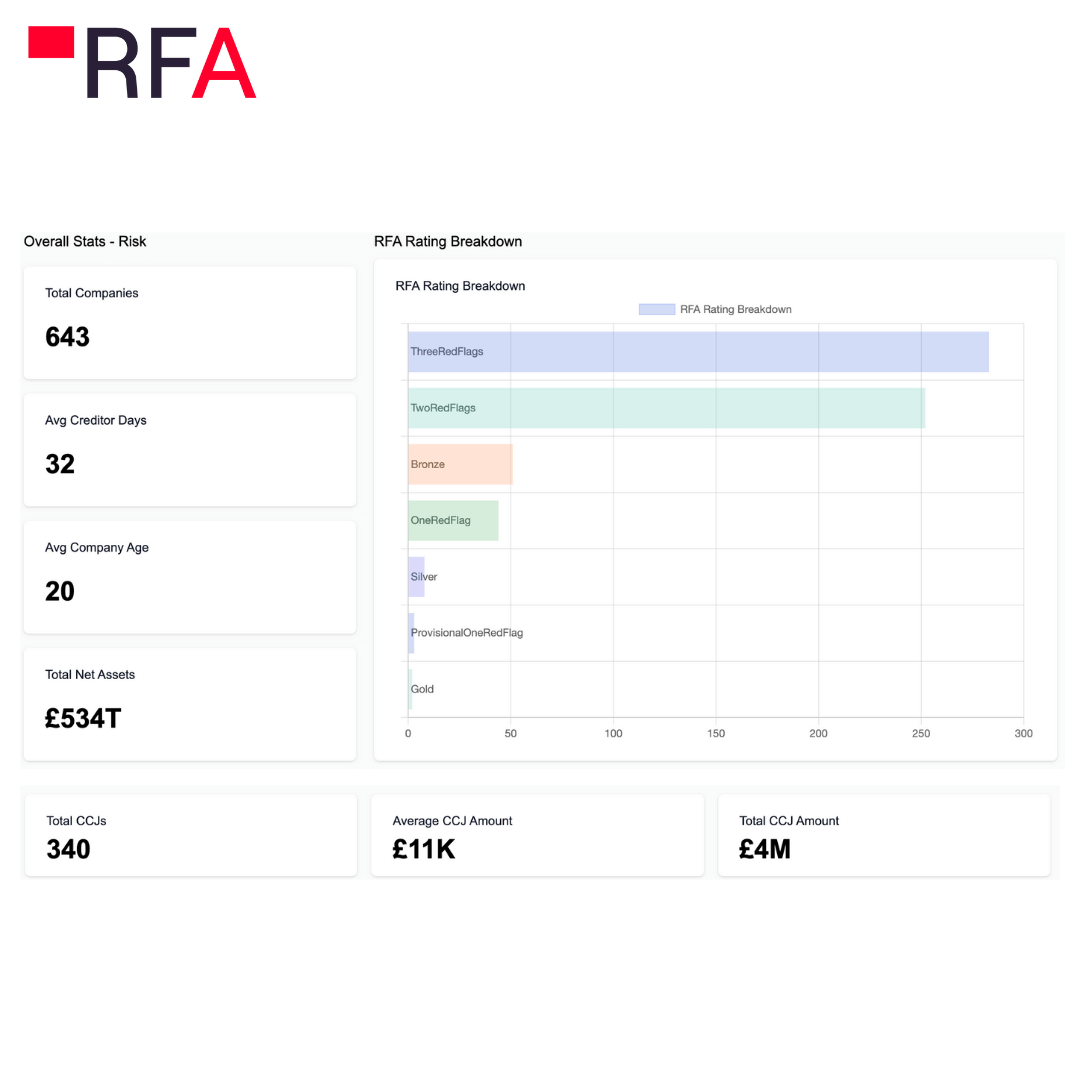Identifying and predicting insolvencies is a challenging task for businesses, but Red Flag Alert has the much-needed solution, with industry-leading software spearheading effective and actionable company monitoring.
Businesses utilising Red Flag Alert's tools can proactively engage with the data, improving strategic measures and their overall confidence, supporting swift decisions that lead them closer to growth and success.
Red Flag Alert’s Insolvency Prediction Warnings
Recently, our experts revealed that Red Flag’s business data is so powerful that we accurately predicted 1,242 insolvencies in the last 30 days. As a result, Red Flag Alert users were given a pre-warning time of up to 16 months, with an average of 110 days.
This much warning, before potential insolvency takes place within partnerships, suppliers, clients, and more, gives organisations a valuable head start.
When alarm bells ring, businesses can leverage this extended timeframe to take decisive actions. Implementing robust financial planning, cost-cutting measures, and exploring restructuring options are crucial steps. Strengthening relationships with creditors, negotiating payment terms, and diversifying revenue streams can also mitigate the impact of impending insolvency.
Red Flag Alert's software not only serves as a vigilant monitor but empowers businesses to navigate the countdown to insolvency effectively, offering a proactive approach to financial challenges and enhancing resilience.
Even stable companies that have been in operation for decades can unexpectedly encounter bad debt.
At times, bad debtors are unavoidable, posing a risk to any business. We at Red Flag Alert stand resilient, dedicated to shielding businesses from the ripple effect of these financial challenges. Our mission is to provide a robust defence, ensuring that the unforeseen impact of bad debt doesn't disrupt businesses’ stability.
Countdown to Insolvency - Six Months’ Notice
If a business has six months' notice of potential insolvencies among its partners or suppliers, it has a valuable window of opportunity to take proactive measures to protect itself. Here are key steps the business can take six months before insolvency strikes:
Chasing Bad Debts
Proactively chasing debts in the six months before insolvency aids businesses by swiftly recouping 60-70% of outstanding amounts. This strategy not only minimises financial losses but also allows creditors to negotiate, accepting partial payments and strengthening their financial position.
Assess and Diversify Suppliers
Evaluate the financial stability of current suppliers and partners - if insolvency is imminent, diversify the supply chain by identifying alternative suppliers and establishing relationships with multiple suppliers to reduce dependency on a single source. Should it be a supplier is showing signs of potential insolvency, this is also an opportunity to begin sourcing new suppliers to avoid any gaps and delays across the supply chain.
Negotiate Contracts and Payment Terms
Renegotiate contracts with existing partners and suppliers to secure more favourable terms and consider negotiating extended payment terms to improve cash flow and provide flexibility.
Strengthen Contracts
Review and update contracts to include clauses that protect the business in case of supplier insolvency. Include terms that allow for the smooth transition of services or products to another provider.
Monitor Financial Health:
Continuously monitor the financial health of partners and suppliers, even if there's no immediate concern. Utilise Red Flag Alert’s comprehensive financial monitoring tools or services to receive real-time updates on any adverse changes.
Countdown to Insolvency - Three Months’ Notice
If a business has three months' warning of potential insolvencies, it should take swift and strategic actions to mitigate risks and protect its operations. Here are key steps to consider, in addition to the six-month warning steps:
Build Reserves
Create financial reserves to cushion the impact of disruptions caused by partner or supplier insolvency. Having these financial buffers in place can help the business navigate temporary challenges without severe consequences or impact on growth.
Establish Contingency Plans
Develop detailed contingency plans outlining alternative strategies in case a critical partner or supplier faces insolvency. Begin by identifying low-risk backup suppliers with Red Flag Alert’s prospecting tools, and establish a clear process for transitioning operations.
Legal Review
Seek legal advice to understand the legal implications and obligations in the event of partner or supplier insolvency, and ensure contracts have appropriate clauses to protect the business's interests.
Inventory and Stockpile
Assess inventory levels and consider stockpiling essential goods or materials to buffer against potential disruptions in the supply chain.
Countdown to Insolvency - One Month Notice
Customer Impact Assessment
Evaluate how the insolvency of a partner or supplier might affect customers and develop strategies to minimise disruptions, and communicate any changes transparently to maintain customer trust.
Insurance Coverage
Review existing insurance policies to determine if they provide coverage for disruptions caused by partner or supplier insolvency, and consider additional insurance or risk management strategies if needed.
Identify Immediate Alternatives:
Quickly identify alternative suppliers or partners that can step in to fulfil critical roles or provide essential goods and services, and establish emergency contracts or agreements with these alternatives.
Renegotiate Contracts
If possible, enter into rapid negotiations with existing suppliers or partners to adjust contracts, payment terms, or services to accommodate the impending changes.
Early notice is crucial as it provides businesses the time to strategically respond to impending insolvencies. Taking these swift actions protects businesses by enhancing resilience, ensuring continuity, and minimising the financial impact of partner or supplier insolvency within a limited timeframe.
Protect Your Business from Insolvency Risk with Red Flag Alert
Red Flag Alert has revolutionised the monitoring process with specialist-powered tools, including.
Businesses can tailor their portfolios to optimise organisation and allow for more actionable data. Paired with powerful analysis tools, monitoring portfolios is streamlined, providing organisations with clear indicators for prospecting, risk mitigation, and health checks, alongside general trends.
Our specialist developers have made it a one-click process to begin customising the monitoring experience. Users can choose which events are relevant to them and their portfolios, establishing personalised event triggers to ensure only relevant alerts reach inboxes.
This eliminates the influx of overwhelming and spam-like emails, reducing the likelihood of overlooking crucial data points. Instead, it offers concise and actionable daily reminders exclusively when triggered events occur. The tools also streamline the effortless sharing of alerts and list access across departments, aligning team members to enhance visibility, and minimising the risk of delayed critical alerts attributed to staff absence or human error.
Predictions suggest that Britain is likely to see insolvencies soar in the coming year, with over 8,000 businesses becoming insolvent, per quarter in 2024.
Red Flag Alert provides the UK’s best insolvency risk services. Our database features:
- B2B Data on every UK company
- AI algorithm that uses 15 years of company data to identify business insolvency
- Real-time data updates from global sources
- Company Monitoring and alerts tools to assess risks
- Additional AML checks and sales prospecting tools
- Companies use Red Flag Alert’s insolvency risk services to check which clients and potential clients pose a credit risk.
Reject conventional monitoring solutions – beat the countdown to insolvency and commit to growth with Red Flag Alert, get a free trial today




